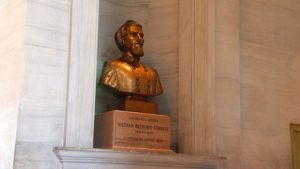 You never can tell what’s going to get people riled up.
You never can tell what’s going to get people riled up.
Last month, the one-ton bronze bust of Confederate Lieutenant General Nathan Bedford Forrest was moved from the Tennessee State Capitol, where it had been on display since 1978, to its new just-down-the-road home in the Tennessee State Museum. I posted a photo of the bust on my Facebook wall and wrote GOOD-BYE AND GOOD RIDDANCE.
Reaction was swift and strong. Many people agreed with me. But those who didn’t told me in no uncertain terms that I was wrong not to consider Forrest a hero. “I doubt you know the whole truth about Forrest’s life,” one critic said. “In my mind he will always be a great Tennessean who loved the South.”
Another told me that my historical knowledge is twisted. “It’s a shame you know so little about this man’s life,” he wrote. “Are you aware that over 2,000 African-Americans attended General Forrest’s funeral and that one of the eulogies was given by a black pastor?” Still another opined that if we don’t quit whining and removing statues, the South will have no history left.
Alrighty then. It was clearly time for me to do some digging.
Research for a column about Forrest I wrote a couple of years ago was confirmed. He amassed a huge fortune, one of the largest in the south, from the slave market he operated in Memphis beginning in 1852. Estimates are that about 7,500 enslaved persons were bought and sold in that market. Forrest had no reservations about splitting families apart and was, apparently, quite enthusiastic about the whipping post.
In terms of the role he played in the Civil War, he was, unquestionably, one of the most impressive cavalry commanders on either side. Forrest enlisted in the Confederate army as a private and rose to the rank of Lieutenant General. Known as “The Wizard of the Saddle,” Forrest reportedly had 29 horses shot out from under him. Although the details of what happened at Fort Pillow in 1864 are murky, historians do know that Forrest’s men overran the Union garrison there and demanded unconditional surrender. When the Union soldiers—most of whom were members of the United States Colored Troops—threw down their arms, most were shot or bayoneted by Confederate troops. Almost 300 men were massacred in cold blood. Though some questions remain about Forrest’s precise role in this tragedy, it’s clear that the army that did the killing was under his command.
Though Forrest wasn’t present in 1867 at the meeting where the Ku Klux Klan was formed, he was elected its leader. The Wizard of the Saddle was now the Grand Wizard of the KKK.
Yeah, his fans say. But what about the stuff he did later? According to Encyclopedia Britannica, “a combination of age, exhaustion and conversion to Christianity seem to have caused Forrest’s fiery temper and racial attitudes to moderate in his later years.” In 1875, he spoke to a group of former slaves at the convention of an organization that was a precursor to the NAACP, expressing in a short speech the opinion that blacks had the right to vote and that their roles should be elevated. And, yes, many African-Americans were part of his funeral processional.
Are the positive things Forrest said and did near the end of his life too little too late? That’s not for me to judge. I’m glad the controversial bust of this controversial figure wasn’t tossed on the garbage heap or rolled into the Cumberland River. It’s exactly where it should be, one of six displays at the Tennessee State Museum in which Nathan Bedford Forrest is featured in historical context. Why not go see them and decide for yourself?
The museum, located at 1000 Rosa Parks Boulevard in Nashville, is open every day but Monday. Admission is free.
(August 14, 2021)